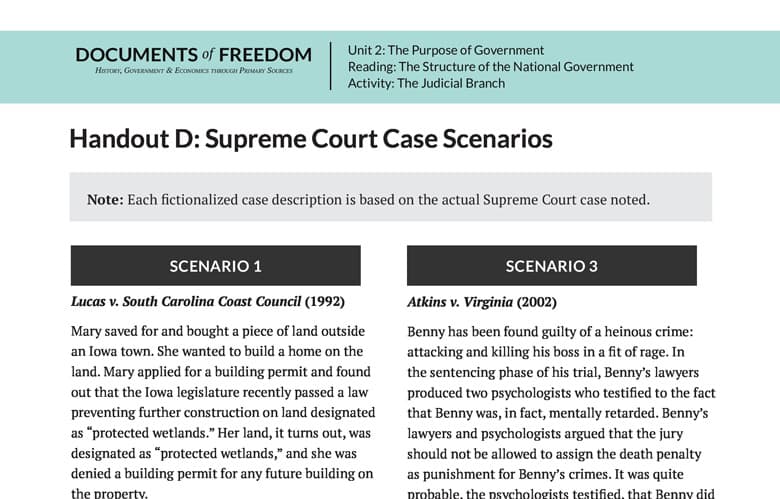Handout D: Supreme Court Case Scenarios
Handout D: Supreme Court Case Scenarios
Note: Each fictionalized case description is based on the actual Supreme Court case noted.
SCENARIO 1
Lucas v. South Carolina Coast Council (1992)
Mary saved for and bought a piece of land outside an Iowa town. She wanted to build a home on the land. Mary applied for a building permit and found out that the Iowa legislature recently passed a law preventing further construction on land designated as “protected wetlands.” Her land, it turns out, was designated as “protected wetlands,” and she was denied a building permit for any future building on the property.
SCENARIO 2
Santa Fe Independent School District v. Doe (2000)
The student body of Lakewood High School, a public school, took a vote. By a vast majority, they voted to conduct a student-led prayer over the public address system of their football stadium before the kick-off of each home game. They elected Paul, the student body president, to conduct the non-denominational prayer. Jane, an atheist, objected. She was neither required to participate, nor punished for refusing. Nonetheless, Jane believed the public prayer itself to be unconstitutional.
SCENARIO 3
Atkins v. Virginia (2002)
Benny has been found guilty of a heinous crime: attacking and killing his boss in a fit of rage. In
the sentencing phase of his trial, Benny’s lawyers produced two psychologists who testified to the fact that Benny was, in fact, mentally retarded. Benny’s lawyers and psychologists argued that the jury should not be allowed to assign the death penalty
as punishment for Benny’s crimes. It was quite probable, the psychologists testified, that Benny did not fully understand the outcome of his actions, and while this fact does not absolve him of punishment, he should not be put to death.
SCENARIO 4
Wisconsin v. Yoder (1972)
Kate and Jim were ardent followers of the Amish faith, and, following Amish doctrine, did not wish
to enroll their children in school beyond the 8th grade. Their state legislature, however, had passed a law requiring all children to attend school until age 16. Such a law, Kate and Jim believed, violated the duties required of them as an Amish family, and they refused to comply with the law. The state prosecuted and punished Kate and Jim for violating the law and refusing to send their children to school.
SCENARIO 5
Miranda v. Arizona (1966)
Darren was arrested on suspicion of kidnapping
and rape. He was taken to the police station,
where the victim picked Darren out of a lineup. An officer pointed to a woman in the police station
and asked if she was the victim. Darren told them, “Yeah, that’s her.” The police then took him to an interrogation room where he was questioned for
two hours. He verbally confessed to the crime, and signed a written statement, prepared by the police, admitting his guilt. Darren’s confession included a statement that he was aware of his rights, and that any statements he made could be used against him. However, the police made little effort throughout the interrogation to allow Darren access to a lawyer, or generally notify of him of his rights.
SCENARIO 6
Sheppard v. Maxwell (1966)
Elaine, a respected physician in the community, was accused of murdering her husband, Adam. Elaine continually maintained her innocence in Adam’s death. The murder trial was a media sensation – reporters were in the courtroom, and were even assigned seats between the jurors and the defendant. The story was all over the local and state press for weeks. Editorials demanded a guilty verdict. The
jury was not sequestered and had access to the media coverage. Elaine was found guilty. After her conviction, Elaine claimed that the extensive media coverage tainted her prosecution, and led to an unfair guilty verdict. She appealed her conviction, arguing that the media coverage biased the opinions of those in her community, and insisting that her guilty verdict should be overturned.
SCENARIO 7
New Jersey v. T.L.O. (1985)
Sara, a public high school student, was caught smoking cigarettes in the school bathroom. The teacher who caught Sara took her to the principal’s office, where a school official questioned her about whether she was smoking in the bathroom. She denied it. The principal, not believing her story, decided to take further action by looking into Sara’s purse. He found a pack of cigarettes as well as a bag of rolling papers commonly associated with drug use. The official then decided to thoroughly search Sara’s purse. He discovered a bag of marijuana and various papers that seemed to indicate that Sara was dealing marijuana. He placed Sara on suspension and called the police.
SCENARIO 8
Brandenburg v. Ohio (1969)
Matt was a prominent leader of the Ku Klux Klan. At a Klan rally, Matt advocated support for the Klan ideal of “white power.” He gave a speech full of racial epithets. He also said, in an apparent threat, “If our President, our Congress, our Supreme Court, continues to suppress the white, Caucasian race, it’s possible that there might have to be some revenge taken.” He was afterwards arrested for violating a state law that prohibited the advocacy of crime, sabotage, or violence as a means of accomplishing political reform. The law also prohibited the gathering of any society or group formed to teach or advocate such messages. Matt was fined $1,000 and sentenced to ten years in prison.
